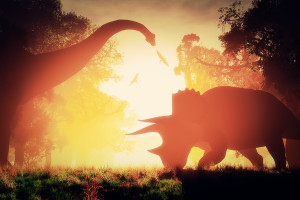I can’t believe Jurassic World is back in theaters. I saw a funny meme recently that asked, “What year is it!?” The truth is, it’s a classic tale with a fantastic idea. Experiencing the Age of the Dinosaurs again? Amazing, and until we have a working time machine, I’ll gladly enjoy the Age of the Dinosaurs through the modern movie effects. What’s old is new again.
What’s old is new again.
Peter Drucker would laugh if he were around today. He’s the guy who coined the classic business advice “the aim of marketing is to know and understand the customer so well the product or service fits him and sells itself,” years ago. What’s old is indeed new again.
Now, in 2015, we are operating within a new age – the Age of the Customer, according to Forrester Research, one that has changed the expectation buyers have from vendors. With so much information at their disposal, on demand, buyers have taken back control of the purchase process, leading Mr. Drucker’s advice to ring more true now than ever before. The company who understands their buyer better and can demonstrate that understanding, wins. This is what it takes to stay competitive in today’s business environment.
Customer-centricity is a leading initiative.
This Age of the Customer is causing many organizations to double-down efforts to become customer-centric. The proof is in the pudding. Deloitte and Touche found that customer-centric companies are 60% more profitable than those not focused on the customer (cue the DUH!’s from the audience.) PWC found that 63% of CEO’s want to rally their organizations around the customer as a top investment priority this year.
As noted in this recent article in the Harvard Business Review, there has been a shift in what companies need to maintain relevance and stay competitive. Companies who were exclusively focused on external forces affecting their industries (such as new entrants to the market, brand equity, substitute products/services, customers’ bargaining power) are now focusing these efforts on the customer, to understand them more deeply, and to serve them better through more tailored products and services.
Three Examples of Customer-Centricity
Three companies highlighted in the article take customer-centricity beyond lip service, and put it into action.
- IBM uses a hybrid design-engineering approach called IBM Design Thinking to put users, rather than features, first, in the planning process, and do it with speed. Over 100 product teams have embraced it, and their business units are growing revenue by double digits.
- Rich Products has broken the silos between departments in the product development process. Instead of a lengthy route of marketing chasing down R&D, QA, regulatory, packaging, and plant contacts with a new feature request form a client, they have taken a new, cross-functional approach that responds quickly to customer needs.
- Intuit saw major growth, but with it, distance from customers’ true needs, and Net Promoter Scores were flat lining. In response, they implemented a cultural and operating initiative called “Design for Delight” where empathy for the customer and experimentation is encouraged, and expected. What’s more, when the company’s CEO does site visits, he meets with customers first.
Takeaways for Marketers
- These examples show the effects of customer-centricity is not limited to marketing, but for organizations without such initiatives in place, marketing leaders should consider this a rally cry to champion a better understanding of their buyers internally.
- The #1 priority for B2B marketers in 2016 will be understanding buyers, according to research conducted by the ITSMA. The fact is, the marketing department is being looked internally to as the resident experts on the customer. Be prepared with the insights and tools for sharing customer insights across the business.
- Being customer-centric is not a one-time project. One of the largest reasons buyer personas fail is that marketers consider them a temporary fix to a larger problem. Effective customer intelligence requires continual understanding of buyers as their priorities, drivers, environments, technologies, pressures, information sources, regulations, and more change.
